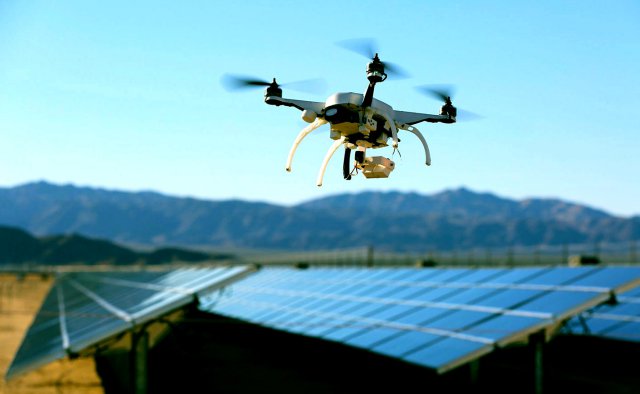 Skycatch, a year-old start-up based in San Francisco that has raised $3.2 million from Google and other investors, builds UAS for the energy industry. The company has already signed deals to test its technology with the construction giants Bechtel and DPR; First Solar, a developer of photovoltaic power plants; and SolarCity, a solar panel installer.
Skycatch, a year-old start-up based in San Francisco that has raised $3.2 million from Google and other investors, builds UAS for the energy industry. The company has already signed deals to test its technology with the construction giants Bechtel and DPR; First Solar, a developer of photovoltaic power plants; and SolarCity, a solar panel installer.
UAS from Skycatch and more established companies are monitoring power lines, inspecting oil and gas pipelines, checking wind turbines for defects and pinpointing malfunctioning solar panels.
“UAS can do just about anything the energy companies don’t want to send people to do,” said Michael Blades, an analyst for the research firm Frost & Sullivan, who studies the unmanned aerial vehicle, or U.A.V., industry.
The Federal Aviation Administration in 2007 imposed what amounted to a nationwide no-fly zone on commercial UAS in the United States while it wrote rules regulating their operation, but in March an administrative law judge for the National Transportation Safety Board ruled that the F.A.A. had no authority to impose such a ban. The F.A.A. said it expected to issue regulations for the commercial operation of small UAS by the end of this year.
While it is not clear what regulations will eventually emerge, a host of companies is planning to take to the skies with UAS. Amazon has said it plans to deliver packages with UAS, and Google just purchased Titan Aerospace, a maker of high-altitude UAS satellites.
Executives at Aeryon Labs, a Canadian company that made headlines for supplying UAS to rebels in Libya, say energy is a growth area, as sensor-equipped UAS offer a safe, low-cost way to inspect smokestacks, power lines and wind turbines without having to send workers to scale towers or hiring helicopters, which can cost thousands of dollars an hour to operate.
“To do a detailed inspection of a tower is very difficult, as it’s hard to get close enough, and of course there’s the safety issue,” said Ian McDonald, an Aeryon vice president.
Aeryon has dispatched its drones to look for cracks in wind turbine blades, which can hang hundreds of feet above the ground. BP has deployed Aeryon UAS and thermal cameras in Alaska to scan oil pipelines for hot spots that may indicate structural weaknesses.
Unlike the large, airplanelike military UAS built for combat, commercial U.A.V.s tend to be small and nimble battery-operated helicopters. The advent of cheap 3-D printing of parts, open-source software and cloud computing has let start-ups like Skycatch jump in.
For Christian Sanz, Skycatch’s chief executive, the energy market is more about data than drones. A tech industry veteran, he began tinkering with drones, building his own U.A.V. outfitted with a GoPro camera. He volunteered to fly the UAS over a local construction site and take photos so managers could monitor the project’s progress. Soon he was being deluged with requests.
“It was this massive demand for data that led me to start the business,” Mr. Sanz said.
He also realized that potential customers did not want to devote time and resources to flying UAS themselves.
Skycatch UAS are designed to operate autonomously. When a UAS completes a mission, it flies back to a ground station, a 100-pound, 2-by-2-foot box with a circular opening on top. As it nears, guided by its camera, G.P.S. and a sonar sensor, the ground station uses its own sensors and a radio signal to guide the approach. Once the UAS has landed, a robotic arm removes the battery, which also stores 15 gigabytes of data, and replaces it with a fresh one from a 10-battery carousel. The data is then beamed up to Box, a cloud computing service.
Mr. Blades, the analyst, said the companies that succeed would be those that minimize their costs by developing low-cost U.A.V.s that operate autonomously.
SolarCity, a Silicon Valley company that is one of the nation’s largest installers of solar panels, tested Skycatch’s technology last month.
“We’re looking at using the U.A.V.s to do operation and maintenance and replace some of our labour-intensive site-surveying duties,” said Damien Scott, SolarCity’s vice president for engineering.
UAS may prove particularly useful at detecting malfunctioning solar panels, which generate a distinctive heat signature as they fail. “Right now, you would have to have employees use hand-held devices to find them by making their way around a large installation,” Mr. Scott said.
At remote photovoltaic plants in the desert Southwest, solar panels can number in the hundreds of thousands.
Mr. Sanz said some companies were interested in deploying UAS to detect protected wildlife that may wander onto a wind farm or solar power installation. “With a U.A.V. flying close to the ground, they can find all these endangered species that can shut down a project,” he said, suggesting that a UAS could be used to scare off birds that fly too close to a wind turbine.
Bouygues, the French construction and energy conglomerate, uses operator-flown UAS to inspect power lines but plans to test Skycatch’s autonomous system at a building site in Miami.
“There are cases when you want the drone to be up 24/7,” said Sébastien Wickert, an executive for a Bouygues subsidiary in San Jose, California.
Source: New York Times
